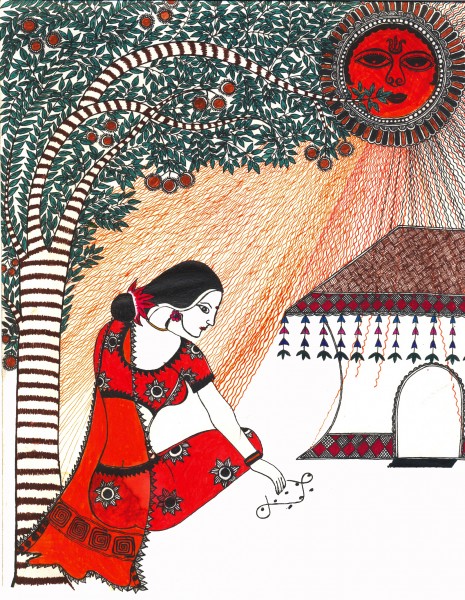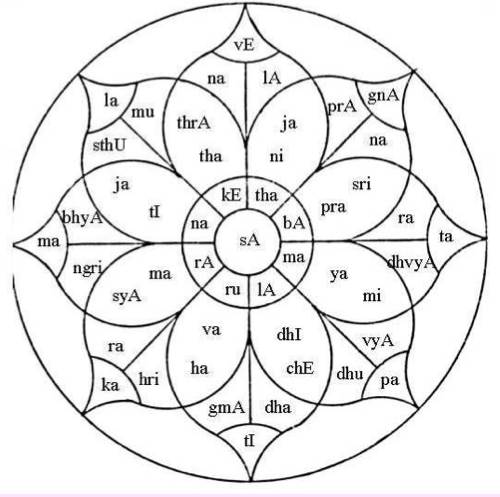Sri RanganAtha padhukA sahasra shlOkams composed by Swami Desikan are all very powerful.
They have tremendous mantra siddhi and kaarya siddhi. Those from the chitra paddhathis (the 7 Yanthrams picked for the seven days) are very auspicious for worship by the ladies in this context.
Rice flour is the best for drawing the kolam .It can also be drawn on white cloth with colored dye (yellow) or drawn on copper or silver /gold plates. The aksharams can be invoked thru the japam, if you are drawing with rice flour. For yanthrams in copper plate, aksharams can be drawn and preserved for continuous use.
If you use rice flour the visarjanam (removal) can be done with the prayer
“SRI RANGANAATHA PAADHUKEE: GACCHA SRI RANGANAATHA PAADHAM YATHA SUKHAM”
The yanthram itself is the Aaradhya moorthy. Additional deities need not be invoked or placed on yanthrams. Please use them. Please draw these kolams in your pooja gruhams, recite the shlokams of the day and after that gently remove by hand, the yan- thram after prostrating before it. Swamy Deshikan’s limitless skill as a poet is revealed in the creation of these slOkams in the yanthram (sabdha chithrams) in Sri RanganAtha PaadhukA ahasram (1000 shlOkams composed in less than three hours) in chithra padhathi section of the Sahasram.
Paadukha Yanthram for Sunday can be found at: http://anudinam.org/2012/03/23/paadukha-yanthram-for-sunday/
Paadukha Yanthram for Monday can be found at: http://anudinam.org/2012/03/28/paadukha-yanthram-for-monday/
For Tuesday:
SaakEtha ThrANa vELAjanitha tathanijaprAngaNa SrIprabhAsA
SaabhA prasrIDavyAm iyamamama yamivyApadhucchEdhilAsA
SaalAdhicchEdha tigmA havarururu vaha hrIkarasyAmarAsA
asaa RaamasyAngrimapyAjati na na nathijasTUlamuthrAtakE Saa
ஸாகேத த்ராண வேளா ஜநித தத நிஜ ப்ராங்கண ஸ்ரீப்ரபாஸா
ஸாபா ப்ரச்ரீ: அடவ்யாம் இயம அமம யமி வ்யாபத் உச்சேதி லாஸா
ஸாலாதிச்சேத திக்ம ஆஹவ ருருரு வஹ ஹ்ரீ கரஸ்ய ஆம ராஸ அஸா
ஸா ராமஸ்ய அங்க்ரிம் அப்யாஜதி ந ந நதி ஜ ஸ்தூலம் உத்ராதகே ஸா
Meaning: We go back to the times, when PaadhukA was ruling over AyOdhyA seated in the royal court, it spread its splendid effulgence over the whole courtyard- its effulgence of Pure Knowledge, effulgence of its greatness and fame. The hall is filled with Vedic effulgence and is capable of rooting out all foes, that too in a sportive manner in the case of sages, who have totally banished conceit banished concept that remove the ten- dency — prattle and removing the tendency to indulge in idle prattle. As Raama, as in this Vishnu form, He extracted the “essence” of the foe, that is, haughtiness and bow (weapon) of the foe. As the fierce fight was going on, it caused a sense of shyness, modesty and defeat, when Raama’s elbow power became evident. The PaadhukAs of that Lord recommends the poor, pitiable, people needing help, who bow to the LOrd in abject surren- der to the feet, Which shines in exhilaration.
பொருள் – அயோத்தியைக் காப்பாற்றி அரசாண்ட காலத்தில் அமைக்கப்பட்ட ராஜசபையின் ஆஸ்தான மண்டபத்தில் தனது ஞானம், ஐச்வர்யம் முதலானவற்றுடன் கூடிய ஒளியை உடையவள்; இதனால் மேலும் அழகும் மேன்மையும் அடைந்தவள்; மேன்மேலும் வளர்ந்த ராஜ்யசெல்வம் கொண்டதாக விளங்கியவள்; ஸம்ஸாரம் என்ற காட்டில் மமகாரம், பொருள் ஆசை, பற்றுதல்கள் போன்றவை இல்லாமல் வாழ்கின்ற உயர்ந்தவர்களுக்கு, சத்ருக்கள் மூலம் உண்டாகவல்ல ஆபத்துக்களை அடியுடன் வெட்டிச் சாய்ப்பதைத் தனது விளையாட்டாகவே கொண்டவள்; அதிக ஞானம் பெறாதவர்களாக இருந்தாலும் ஸ்ரீரங்கநாதனையும், பாதுகையையும் போற்றி நிற்பவர்களின் தவறான சொல் அமைப்புக்களை நீக்கி, அவர்களுக்கு ஞானமும் உயர்ந்த சொற்களையும் கொடுத்தபடி உள்ளவள் – இப்படிப்பட்ட ஸ்ரீரங்கநாதனின் பாதுகை மேலும் செய்வது என்ன? ஸாரம் என்ற பலம் போன்றவற்றை முறியடிப்பதில் மிகவும் உக்ரமான யுத்தம் நடக்கும்போது, மானைக் கையில் ஏந்திய சிவனுக்கு தனது “ஹும்” என்ற ஓசையால் மட்டுமே பயந்து வெட்கம் ஏற்படும்படிச் செய்த இராமனுடைய திருவடிகளை வழி நடத்துகிறாள். இந்தத் திருவடிகள், ரக்ஷிக்கத் தகுந்தவர்கள் செய்கின்ற வணக்கம் காரணமாக மிகவும் மகிழ்வுடன் உள்ளன அல்லவோ?
Special Notes by V. Sadagopan:
This slOkam is set in Kavi nAmAngitha ashta dhaLa padhma chithram. This includes a lotus chakram with the name of the poet, who composed this brilliant kAvyam (Venkatapathi Kamalam). Venkatapathi is the other name for VenkatanAthan (Swami Desikan), the author of this brilliant kAvyam. The ladies of the house for worship use this slOkam on TUESDAYS Swami Desikan. This slOkam is in SragdharA metre and each paadham has 21 aksharams:
sAkEtha thrANa vELAjanitha tathanijaprAnkaNa SrIprabhAsA sAbhA prasIDavyAm iyamamayamivyApathus-cchEdhilAsA sAlAdhicchEdha tigmaa havaruru vaha hrIkarasyaamarAsA- saaRaamasyAngrim abhyajAthi na na nathijasTUlamuthrAtakE
1.UtthamUr Swami’s anubhavam: This slOkam celebrates SrI RaamachandrA and His glorious deeds through the salutation to SrI Raama PaadhukAs. The slOkam says: “SrI Raama PaadhukAs have a natural luster. They are known for the fact that the VedAs eulogize them. At TaatakA forest, these PaadhukAs removed the danger that the egoless yOgis faced. Later, when they ruled over AyOdhyA and protected the citi- zens, the sound that they made created a glow around them. They remove the sorrows of those who have not perfected their sense of true knowl- edge. These are the PaadhukAs of SrI RaamA, who defeated Rudra in war and which broke the bow of Siva at Mythilai. They made RudrA holding a deer in His hand feel ashamed over his defeat. These are the PaadhukAs commanded by Raama to rest on the heads of His devotees. They also make it possible for RaamA’s sacred feet to approach their heads. They destroy asubha sankalpams.
2. Srimath Andavan’s anubhavam: In the 934th slOkam, the focus was on how the Paadhukais destroy the sins of Paapis through some vyAjam (excuse) and uses their PurushakAram with the Lord to accomplish that act.
Next, the Vaathsalyam for aasritha Janam, nithya yOgam with the Lord were described. That was followed by the examples of upakArams along these lines such as ViswAmithra Yaaga SamrakshaNam. Next the acquisi- tion of bhagavath guNams by the Paadhukais due to Bahgavath samb- handham was described. Now, the description of the samrakshaNam of MahA Paapis by the Paadhukais is continued. SaraNAgatha samraksha- Nam as Sarva Saasthra Saaram is the theme here again. The PurushakAra kaashtai of the Paadhukais in persuading the Lord to protect the saraNA- gatha jeevans is described.
3. The division by padhams (16 units) of this long slOkam is as follows:
a) SaakEtha ThrANa vELA janithatha nija prAnkaNa Sri PrabhAsA: Dur- ing its PaadhukA Raajyam at AyOdhya for 14 years, the Paadhukais had the glorious effulgence arising from their gold and gems as they sat on the throne of Raghus in the middle of the raaja sabhai full of great-learned souls.
b) SaabhA: they possessed Kaanthi (Keertthi shObhitham) then.
c) Prasree: the Kaanthi arose from the eternal Veda Sampath (SaamAnya &
Sookshma Jn~Anam.
d) aDavyAm: In the TaaDakA Vanam (during Yaj~na rakshaNam).
e) Iyam: This Raama PaadhukA
f) AmamayamivyApadhucchEdhithalaasA (amama +yami + vyApath+ uc- chEdhi +laasA):
That PaadhukA with the playful acts of protecting the egoless yOgis from dangers that confronted them in the TaDakA forest.
g) Saaladhi-cchEdha thigma aahava ru hUm ruru vaha hrIkarasya: These PaadhukAs of the Lord with its power made Rudra –with the mark of deer in his hand– flee the battle field through their hUmkAra sabdham.
h) AamarAsasA: Those PaadhukAs, which removes the ignorant words and creates the good tatthva Jn~Anam in aasrithAs.
i) Raamasya: Those PaadhukAs belonging to VishNu Roopi, Raaman.
j) angrim: of the sacred feet of the Lord
k) (angrim) abhyajAthi na: The Paadukais recommend to the Lord’s feet to accept the aasrithan as an object of protection. (l, m, n) nathijasTUlam +utthrAtakE+ Saa: After seeing the bowed head seeking protection, the Lord’s sacred feet are swollen with joy about SaraNAgatha SamrakshaNa laabham (gain) .This results from the PurushakAram (intercession) of the dhivya PaadhukAs.
To read the figure
Start at the center and follow the lotus petal as below sa
kE tha thrA na vE
lA ja ni thA sA
thA ni ja pra (Note: you repeat thA ni ja backwards and than fork) gna
na sri pra bha sA
bhA pra sri ra (Note: you repeat bhA pra sri backwards and than fork) ta
…. and so on
For more details of Padhuka commentaries series: http://anudinam.org/?s=Paduka+Sahasram
Source and courtesy : Opilliappan Sadagopan Swami(sundarasimham), Madhavakannan Swami, Sriram Srinivasan Swami and Sriman Sunder kidambi Swami, Sridharan Swami (namperumal journal)












Extraordinarily rich and beautiful Web site .MahOnnata Kaimkaryam . May the dhivya dampatis bless this iniitative furhter and further !
NamO SrI nrisimhAya,
V.Sadagopan